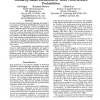Free Online Productivity Tools
i2Speak
i2Symbol
i2OCR
iTex2Img
iWeb2Print
iWeb2Shot
i2Type
iPdf2Split
iPdf2Merge
i2Bopomofo
i2Arabic
i2Style
i2Image
i2PDF
iLatex2Rtf
Sci2ools
ACL
1994
1994
Similarity-Based Estimation of Word Cooccurrence Probabilities
In many applications of natural language processing it is necessary to determine the likelihood of a given word combination. For example, a speech recognizer may need to determine which of the two word combinations "eat a peach" and "eat a beach" is more likely. Statistical NLP methods determine the likelihood of a word combination according to its frequency in a training corpus. However, the nature of language is such that many word combinations are infrequent and do not occur in a given corpus. In this work we propose a method for estimating the probability of such previously unseen word combinations using available information on "most similar" words. We describe a probabilistic word association model based on distributional word similarity, and apply it to improving probability estimates for unseen word bigrams in a variant of Katz's back-off model. The similarity-based method yields a 20% perplexity improvement in the prediction of unseen bigram...
| Added | 02 Nov 2010 |
| Updated | 02 Nov 2010 |
| Type | Conference |
| Year | 1994 |
| Where | ACL |
| Authors | Ido Dagan, Fernando C. N. Pereira, Lillian Lee |
Comments (0)

